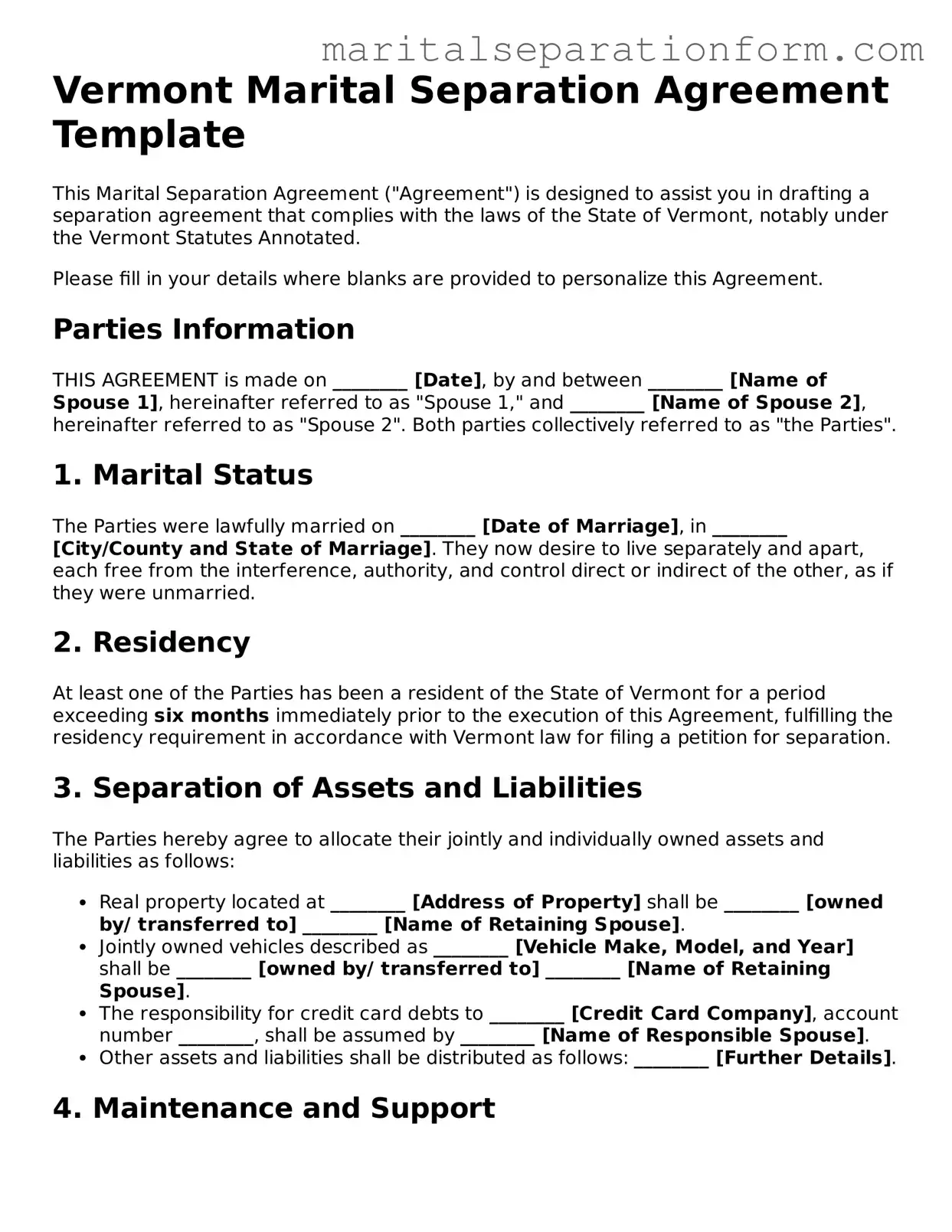Vermont Marital Separation Agreement Template
This Marital Separation Agreement ("Agreement") is designed to assist you in drafting a separation agreement that complies with the laws of the State of Vermont, notably under the Vermont Statutes Annotated.
Please fill in your details where blanks are provided to personalize this Agreement.
Parties Information
THIS AGREEMENT is made on ________ [Date], by and between ________ [Name of Spouse 1], hereinafter referred to as "Spouse 1," and ________ [Name of Spouse 2], hereinafter referred to as "Spouse 2". Both parties collectively referred to as "the Parties".
1. Marital Status
The Parties were lawfully married on ________ [Date of Marriage], in ________ [City/County and State of Marriage]. They now desire to live separately and apart, each free from the interference, authority, and control direct or indirect of the other, as if they were unmarried.
2. Residency
At least one of the Parties has been a resident of the State of Vermont for a period exceeding six months immediately prior to the execution of this Agreement, fulfilling the residency requirement in accordance with Vermont law for filing a petition for separation.
3. Separation of Assets and Liabilities
The Parties hereby agree to allocate their jointly and individually owned assets and liabilities as follows:
- Real property located at ________ [Address of Property] shall be ________ [owned by/ transferred to] ________ [Name of Retaining Spouse].
- Jointly owned vehicles described as ________ [Vehicle Make, Model, and Year] shall be ________ [owned by/ transferred to] ________ [Name of Retaining Spouse].
- The responsibility for credit card debts to ________ [Credit Card Company], account number ________, shall be assumed by ________ [Name of Responsible Spouse].
- Other assets and liabilities shall be distributed as follows: ________ [Further Details].
4. Maintenance and Support
The Parties agree that ________ [Name of Spouse] shall provide alimony payments to ________ [Name of Other Spouse] in the amount of $________ per month, starting on ________ [Start Date] and ending on ________ [End Date], unless otherwise modified by the court or upon the occurrence of a condition specified herein.
5. Children
In matters of child custody, visitation, and support for the children of the marriage, named: ________ [Child’s Name], ________ [Child’s Name], and ________ [Child’s Name], the Parties agree to the following terms:
- Custody of the children shall be ________ [Type of Custody].
- Visitation rights and schedules for the non-custodial parent shall be as follows: ________ [Details of Visitation].
- Child support payments shall be made by ________ [Paying Parent’s Name] in the amount of $________ per month, beginning on ________ [Start Date].
6. Entire Agreement
This document constitutes the entire agreement between the Parties pertaining to the subject matter hereof and supersedes all prior agreements, understandings, negotiations, and discussions, whether oral or written, of the Parties. No amendment or modification of this Agreement shall be deemed effective unless in writing and signed by both Parties.
7. Governing Law
This Agreement shall be governed by and construed in accordance with the laws of the State of Vermont, without giving effect to any choice or conflict of law provision or rule.
Signed this ________ [Date]:
_________________________________
________ [Name of Spouse 1], Spouse 1
_________________________________
________ [Name of Spouse 2], Spouse 2
